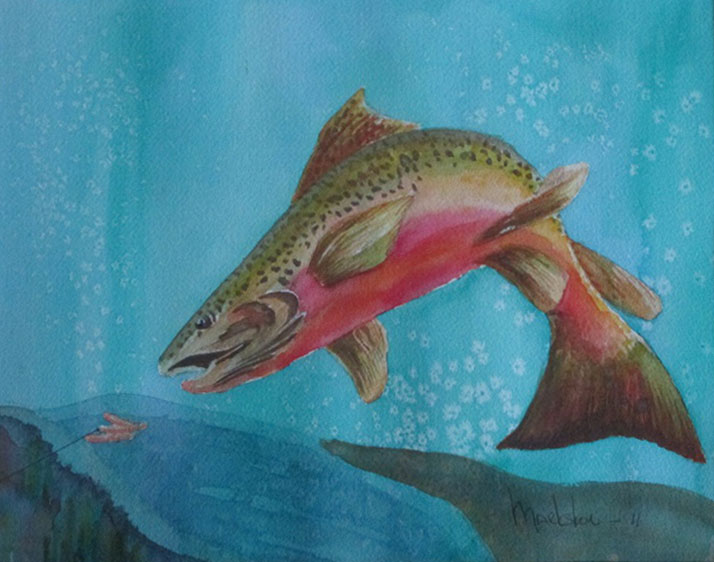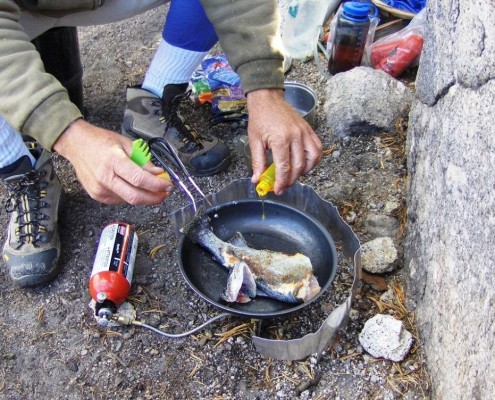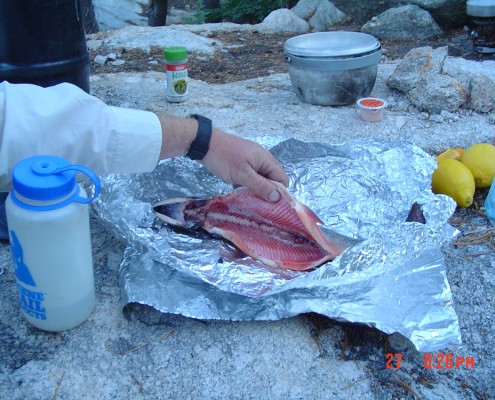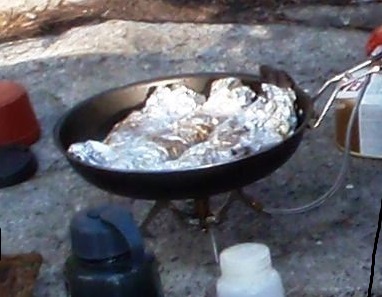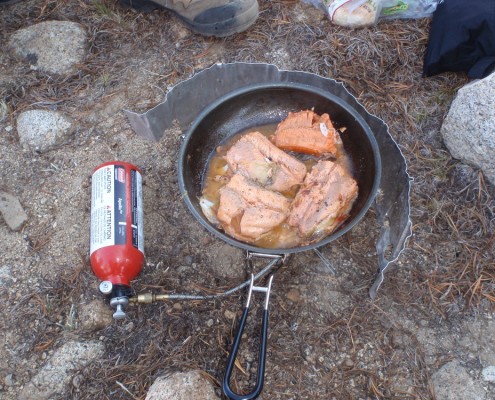Culinary Aspects of Sierra Trout, Safe Practices, Gutting/Cleaning and Cooking Methods
By: markskor
Published May 16, 2015
Last updated May 16, 2015
The following is an article/discussion on some culinary aspects of Sierra trout, safe practices, keeping some to eat, how to gut/clean a trout, and various cooking methods both below and above the “no fires allowed” zone of the Sierra Nevada.
Trout Keeping –
For many anglers known here on High Sierra Topix and elsewhere, catch and release (C&R) does not necessarily mean all trout caught have to be released – some are destined for dinner. The questions is, which ones to keep and how many? Tough decision – all depends on size, local fishing regulations, and appetite. By the way, wild, freshly-caught, trout do not travel well long distances and especially un-refrigerated – please keep only what you will definitely eat immediately – never waste this prized resource.
Small trout, although tasty, are a pain to cook. Large lunkers (excluding stockers) should always be returned back to the water (or never taken out?) as they are prime Sierra breeding stock. If a trout dinner is planned (and the fishing good) if at all possible try to keep/select a few of the fatter fish (ones with shoulders?) in the 12 – 14 inch range. Beyond keeping fish based upon size, no matter how careful one may be (when practicing good C & R, always use single hooks only, no trebles ever!), trout will at times be inadvertently gill caught. More times than not trout are destined to die momentarily once the gill arch shows any signs of bleeding so you might as well keep these too.
Where/How to Keep Trout Fresh –
After deciding that this one is a keeper/dinner – what’s next? At first, after clearing the hook (hemostat to remove), previously you would just run a stringer through the gills/mouth and tie off the stringer to any convenient rock/bush letting the roped fish swim/ remain alive in the water. However, recent evidence shows this method is actually cruel to the fish and the resultant “being caught” trauma sends out caustic internal chemicals inside the fish causing once-firm meat to break down quickly (changing the taste?). This process occurs from the moment a fish is caught until (once initiated) long after the trout expires. Better a sharp wrap on the fish’s head immediately to quickly arrest any unnecessary deterioration of the meat. Additionally, (even though there is no real evidence backing this up other than observation) stringered, live, swimming trout (Golden trout anyway) may be able to somehow magically communicate their plight to other nearby trout – a warning to others not to bite in the vicinity of the caught area.
(I could be wrong here though.)
Carry a large gallon-sized baggie – expired trout then sealed up, tight/dry and kept cool inside same, either underwater under a rock, somewhere in the shade, or covered/stashed in a nearby snow field until cleaning time and heading back to camp.
How to Clean a Trout –
Some like the idea of filleting trout, some don’t… As trout are not that big and the bones come out clean when cooked correctly, I never do. If you want, you can Google search on various filleting methods, many of which include detailed how-to pictures. If like me and you’re not a fillet-er, there are two main techniques – both similar.
- Take a knife (no Bowie needed here – a small, sharp, Swiss Army Knife will suffice) and insert 1/2 inch into the anus cavity (small hole) and cut up through the belly, towards the head. Some cut all the way past the pectorals, past the gill arch, and some stop just short of the pectoral connectors. Personally, I prefer the second way.
- Create one small 1/4″ side-to-side slice cutting the little white connective tissue (base of tongue) ventral, between the gills and head, then take your thumb and insert into the gill ring, from the bottom front (not at the mouth), into the cavity under the remaining connected flesh, (the part still joined/under the pectorals).
- Tug down and away, pulling out the gills and all internals. As you’re pulling this away, the pectorals should follow and pull away clean too along with the gills/ guts. If the initial cut was made past the pectorals, then these unwanted fins will remain/ stay with the fish. TIP: A good idea at cleaning time is to check the stomach contents to see what the fish was eating as this information may be useful in selecting a pattern to later on catch his/her buddies.
- After pulling out all loose objects from the fish body cavity you’ll notice a dark vein that extends along the entire length deep inside of the fish. This vein must be cleaned/ removed. Using top of your thumbnail like the back of a shovel, scrape away this red/dark red vein, starting at the rear and moving forward. When you have all the blood remains loosened up, expose the underlying spine by simply shaking the carcass in the water removing anything that may be left over. A final good rinse, the fish is now clean, ready to cook.
- Some anglers opt to leave the head and tail on the fish, some discard them. Keeping or removing these parts is all up to you. The choice usually depends in part on both the individual trout’s length and the pan size carried and available for use at the time.
Cooking Trout Backcountry –
Below that line where campfires are legal / allowed, (much like Bubba Gump shrimp), there are literally thousands of different variations/numerous ways of cooking trout using hot coals. What they all have in common is hot coals so I’ll start there. Build/stoke up the fire twenty minutes prior, letting it then die down some, amassing a decent pile of larger chunky, hot coals. There will be no fire to be seen per se, but just lots of hot embers that will last ~15 minutes. After that, you can fry, sauté, poach, bake, boil…BBQ. However, a pot with a lid, and/or a frying pan, and/or a metal grate, and/or aluminum foil, and/or a stick is also needed.
Cook the trout up teriyaki style, as fish tacos, pan fried, trout almondine, smoked, meuniere, butterflied, planked, blackened, wrapped with bacon, cooked in a pouch, grilled, use lemon, Ritz-crusted. There are on-line recipes for Mushroom and Artichoke Stuffed Trout, Trout Fricassee, Trout Orleans, Escabeche of Trout, Portuguese-style Trout, Citrus Trout Almondine, Cornmeal-Crusted Trout, and Bacon Grilled Cajun Trout. There is Trout with Pecan Meuniere Sauce, Smoked Trout Salad with Grilled Fingerlings Potatoes and Mustard-Dill Vinaigrette, Trout Parmesan, West Virginia Trout Tacos, Pecan Crusted Trout, Whole Trout en Papillote, Seared Trout over Succotash, Smoked Trout Dip, Curried Rice with Smoked Trout, and Trout with Caper Sauce. There is Chardonnay Trout, Prosciutto Wrapped Trout, Beer Battered Fried Trout Tacos with Spicy Horseradish Coleslaw, Trout Navarra-Style (Spain), Trout Piemontese Style, ut Amandine with Creole Meuniere Sauce, Georgia Rainbow Trout with Butter Bean Succotash, Rainbow Trout with Jasmine Rice and Citrus Vinaigrette, and Grilled Trout Ciabatta.
There is also Trout in Puff Pastry, Bacon-Wrapped Trout with Rosemary, Pan-Seared Trout with Anchovy Sauce, Fire Broiled Trout, Smoked Trout Salpicon, Trout Grenoblaise with Tian of Zucchini, Braised Trout with Green Sauce, and Rainbow Trout and Prawn Napoleon with Lemon-Shallot Beurre Blanc Sauce. Additionally you can have Vanilla Smoked Trout, Pin-Trout, Whole Crispy Brook Trout with Mango-Pineapple Sauce, Blue Corn Crusted Rainbow Trout with a Roasted Peppers, Savory Trout Cheesecake, Barbeque Smoked Trout Fillets, Rollmops, Caponata Pasta Baked trout, Seafood Trout Jambalaya, and Herb Crusted Trout with Shiitake Sticky Rice and Shiso Oil…just to name a few. 🙂
Google for the recipes.
Above 10,000 feet in the Sierra Nevada, in the “no fires allowed” zone, obviously there will be no (legal) embers or hot coals to cook over… thus some sort of stove (to be legal, one with a required shut-off valve) will be needed. Regarding stove selection, I prefer a remote canister stove like the MSR Windpro or similar. A white gas stove works well at altitude too but then you also are dealing with white gas fumes, gas spillage, and additional weight issues. Alcohol stoves are pretty much useless for cooking fish at altitude. Along with a hot/wide-flamed/stable stove of your choosing you will also need to carry a fry pan and/ or a pot with a lid. Here are three, possible, high altitude, trout cooking methods – play with spices to achieve your desired flavor:
Poached – submerge the fish in a gently simmering liquid such as court bouillon, other stocks, or water flavored with aromatics including spices, citrus, or vegetables. Cover and simmer for 8 – 10 minutes or until trout is opaque and flakes easily when tested with a fork. Result: tasty but mushy trout.
Pan Fried – in a (larger-the-better) skillet/fry pan, heat 3 – 4 tsps oil over medium-high heat.
(Optional – In shallow dish, combine flour, cornmeal, salt and pepper. Dredge fish in flour mixture.) Fry trout in hot oil for about 4 to 6 minutes on each side or until meat flakes with a fork. Serve immediately. Result: excellent recipe – simple – great trout flavor – clean-up however, can be a messy pain.
Foil Wrapped – make/carry a few heavy-duty aluminum foil squares – 18″ by 18″ – folded in quarters to carry. Wrap spiced trout (+/- heads & tails) in an aluminum foil packet with a little olive oil sprinkled/drizzled outside of the trout. (Important – the oil is essential as it is what actually cooks the trout.) Seal packets up tightly around the trout. (Tip: if cooking smaller trout – 2 or 3 trout to a packet works OK too.) Heat up the frying pan until hot – place 1 or 2 assembled packets of trout in the fry pan, held down / in close contact with the hot pan by a flat rock. Turn packets over occasionally – 10 – 15 minutes total cooking time, depending on how big the trout are and how hot your stove/ fry pan gets. Trout is done when the backbone lifts cleanly away from the meat. Result: great flavor and no cleanup other than the spent foil. Please carry out all the foil remains.
High or low altitude, this last recipe (foil wrapped) has proven to be my preferred trout cooking method. When using foil packets in lower elevations, where fires are legal, just cook them by throwing the fish packets into the coals…
And finally, regarding eating it raw (i.e. sashimi), you should do some research (read this) and proceed at your own risk.
Good Eats!

